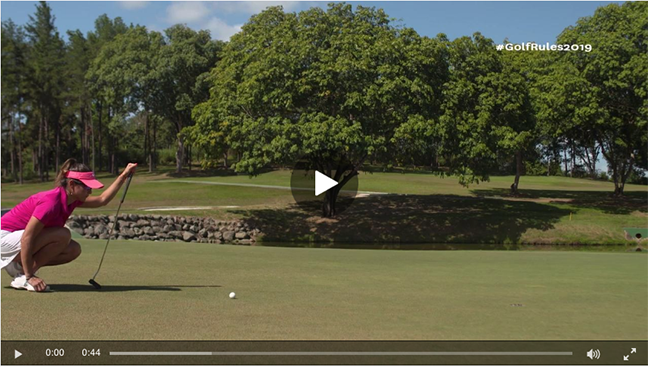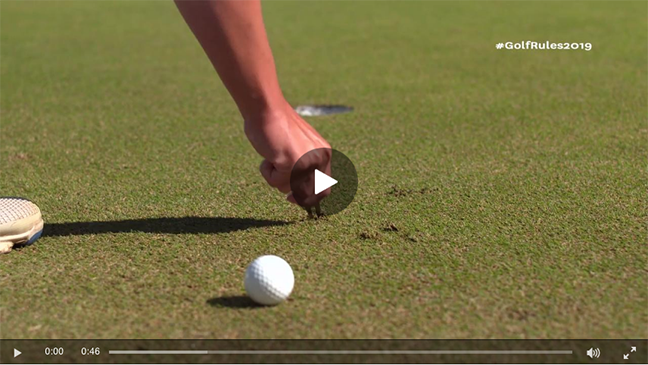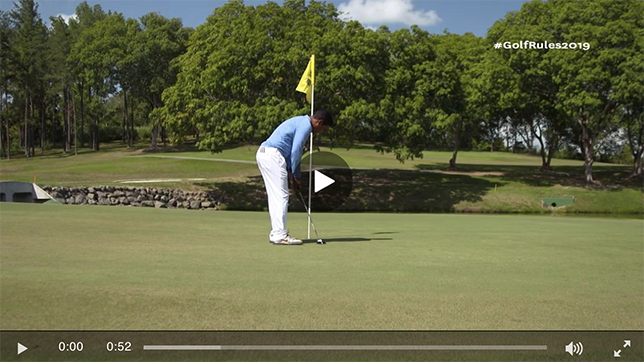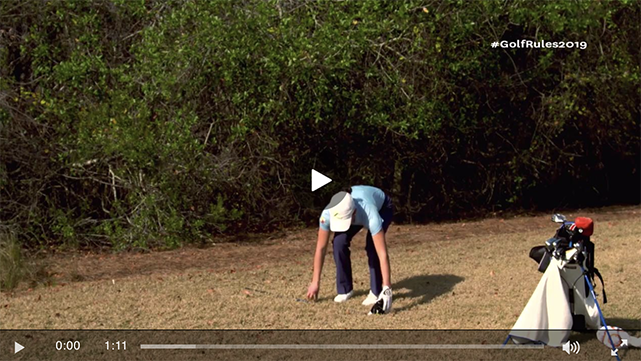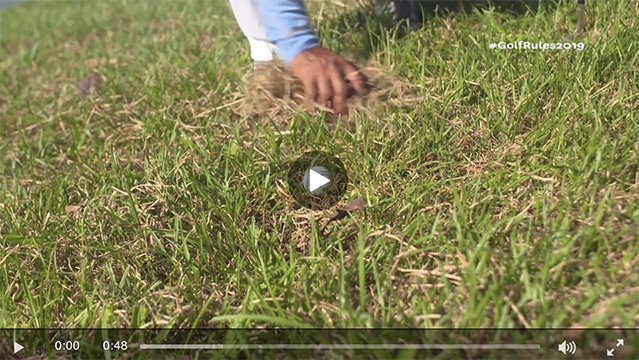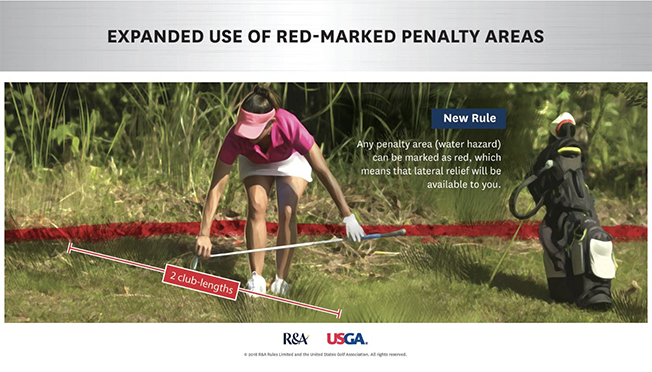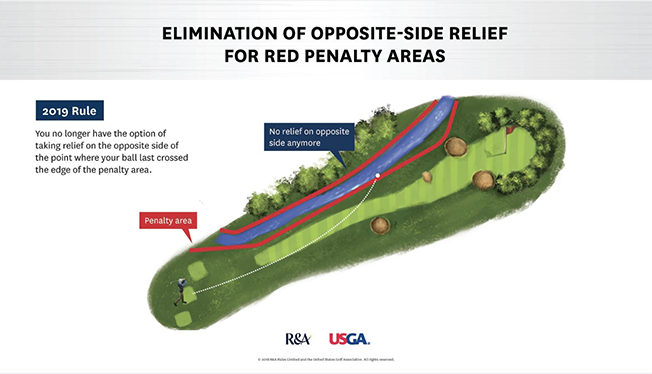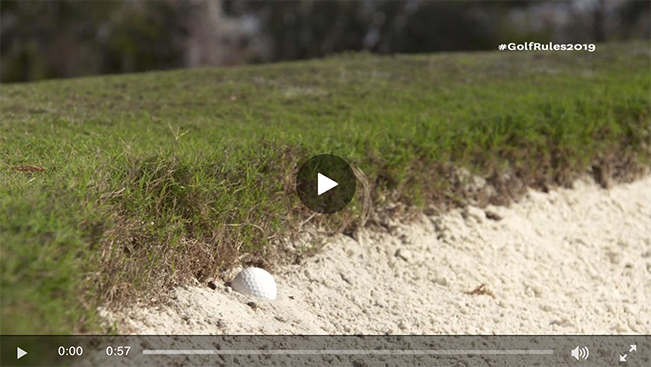Areas of the Course
2019 Golf Rule Changes
Become comfortable with the rule changes to help you this season.
Topic 4 | Areas of the Course
Rule – When to replace a ball that moves on the putting green
After your ball has been lifted and replaced, you would always replace your ball on its original spot, even if it was blown by the wind or moved for no clear reason.
2019 Rule: Rule 13.1d-will revise the procedure for when a ball on the putting green is moved by wind, water or other natural forces, so that it must sometimes be replaced and sometimes be played from its new spot:
- If the ball had been lifted and replaced on its original spot before it moved, the ball must always be replaced on its original spot, regardless of what caused it to move.
- The ball must be played from its new spot only if the ball had not been lifted and replaced before it moved.
Reasons for Change:
When a ball at rest is moved by natural forces such as the wind, it is normally played as it lies because its movement is considered a continuation of the previous stroke, as no person or object has affected where the ball lies.
But when the moved ball had already been lifted and replaced, the connection to the previous stroke is no longer obvious.
This is especially true on the putting green, where a player is allowed to mark, lift and replace a ball for any reason and many players do so as a matter of course.
When a ball on the green moves after having come to rest:
- It can result in outcomes that seem unfair, such as when the ball rolls off the green (sometimes ending up in a bunker or in water) or rolls close to or into the hole.
- Requiring the ball to be replaced if it had already been lifted and replaced will eliminate such outcomes in those situations.
Check out the VIDEO:
Rule – Repairing damage on the putting green
Repair of almost any damage allowed on the putting green (including spike marks and animal damage).
2019 Rule: Rule 13.1c(2) allows repair of almost any damage on the green:
- “Damage on the putting green” will be defined to include all types of damage (such as ball-marks, shoe damage, indentations from a club or flagstick, animal damage, etc.), except aeration holes, natural surface imperfections or natural wear of the hole.
Reasons for Change:
Because putting greens are specially prepared for playing the ball along the ground, the Rules allow the player to do things on the green that are not allowed anywhere else:
- The player may mark, lift and clean a ball on the green at any time, remove sand and loose soil on the green and repair old hole plugs and ball-marks on the green.
- Given this philosophy of allowing players to try to have a smooth surface for rolling the ball, there is no conceptual reason for prohibiting repair of other types of damage (whether made by players, animals, maintenance staff, etc.).
This Rule change will eliminate the frequent questions among players and referees about whether a particular area of damage on the green is a ball-mark that may be repaired or is a shoe mark or other damage that must not be repaired.
The concern has been noted that allowing repair of all damage on the putting green could slow down play if players try to repair too many areas; but we believe this is unlikely to be true for most players and that the Rule against unreasonable delay (as well as a Committee’s pace of play policy) can be used to address situations where a player seeks to make excessive repairs.
Check out the VIDEO:
Rule – Touching line of play on a putting green
No penalty for touching your line of play on the putting green so long as doing so does not improve the conditions for your stroke.
2019 Rule: The prohibition of touching the line of play on the putting green will be eliminated:
- There will no longer be a penalty for merely touching the line of play on the putting green (the term “line of play” will apply everywhere on the course including the putting green, and the term “line of putt” will no longer be used).
- But the player will still be subject to the prohibition on improving his or her line of play on the putting green (see Rule 8.1a, as limited by 8.1b).
Reasons for Change:
No advantage is gained if a player or his or her caddie merely touches the surface of the putting green on the line where the ball will be played.
Over time, the prohibition on touching the line of putt has become subject to many exceptions:
- Current Rule 16-1a lists seven different situations in which a player is allowed to touch the line of putt.
The current prohibition is difficult to administer and penalties are not often applied; and those penalties that are applied may be perceived as serving little or no purpose, such as when a caddie accidentally touches the line of putt with the flagstick.
Check out the VIDEO:
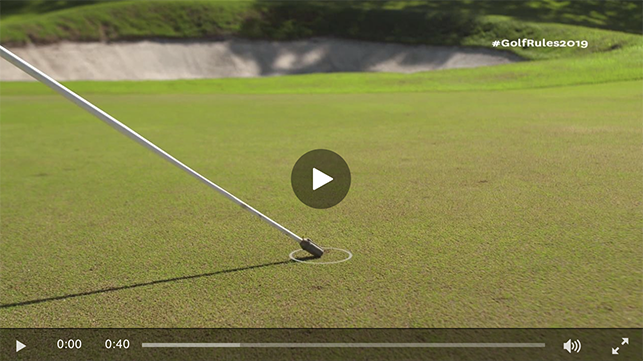
Rule – Ball played from green hits unattended flag stick in hole
No penalty if your ball played from the putting green (or anywhere else) hits the unattended flag stick in the hole.
2019 Rule: Under Rule 13.2a(2):
- There will no longer be a penalty if a ball played from the putting green hits a flagstick left in the hole.
- Players will not be required to putt with the flagstick in the hole; rather, they will continue to have the choice to have it removed (which includes having someone attend the flagstick and remove it after the ball is played).
Reasons for Change:
Allowing a player to putt with the flagstick in the hole without fear of penalty should generally help speed up play.
When the players do not have caddies, the current Rule can result in considerable delay.
On balance it is expected that there should be no advantage in being able to putt with the unattended flagstick in the hole:
- In some cases, the ball may strike the flagstick and bounce out of the hole when it might otherwise have been holed, and
- In other cases, the ball may hit the flagstick and finish in the hole when it might otherwise have missed.
Check out the VIDEO:
Rule – Areas the committee may mark as penalty areas
Areas of desert, jungle, lava rock, etc. (in addition to areas of water) may now be marked as red or yellow “penalty areas.”
2019 Rule: Under the new Rules, “water hazards” will be superseded by the expanded concept of “penalty areas,” and Rule 17 will provide the same basic options for relief that exist under the current Rules:
- A penalty area will include both (1) all areas currently defined in the Rules as a water hazard or lateral water hazard and (2) any other areas the Committee chooses to define as penalty areas (with recommended guidelines to be provided in the guidebook).
- Penalty areas may therefore include areas such as deserts, jungles, lava rock fields, etc.
- The term “hazard” will no longer be used in the Rules.
Reasons for Change:
It has been recognized that requiring areas to contain water seems to be a somewhat arbitrary reason for permitting such relief options.
For reasons such as safety and pace of play, many Committees have sought to expand the use of lateral water hazards by marking areas that do not contain water and by marking water hazards as red where that is not specifically contemplated by the Rules.
The broader use of “penalty areas” will allow Committees to respond to the wide range of settings in which golf is played by giving relief from areas that present similar obstacles to existing water hazards, such as difficulties with finding and playing a ball and similar practical needs about pace of play.
Check out the VIDEO:
Rule – Touching loose impediments or ground in a penalty area
No penalty for moving loose impediments, touching the ground, or grounding your club in a penalty area.
2019 Rule: Under Rule 17:
- There will no longer be any special restrictions when a ball is in a “penalty area” (the expanded designation for the area that includes what are now called water hazards).
- A player will be allowed to touch or move loose impediments and touch the ground with hand or club (such as grounding the club right behind the ball) for any reason, subject only to the prohibition on improving conditions for the stroke (see new Rule 8.1a).
Reasons for Change:
A strict prohibition on touching or moving loose impediments or touching the ground in a water hazard has never been practical, and so a series of exceptions had to be recognized in Rule 13-4 (see Exception 1), Rule 12-1 and various Decisions.
This has created confusion and complications in applying the Rules, such as needing to decide when a player was or was not “testing,” what constitutes touching “as a result of or to prevent falling,” and similar questions about applying the many exceptions.
The current prohibitions have led to penalties that some view as overly harsh, such as:
- Where the breach was so inconsequential that the player could not have gained any advantage or where even a careful player could not have avoided the penalty, and
- In a televised competition, where the breach could not be detected by the player or others on the course and was discovered only through later video review.
Treating a penalty area the same as the general area for these purposes will simplify the Rules, reduce confusion and eliminate unnecessary penalties.
Removing these restrictions is consistent with the purpose of a penalty area – which is not necessarily to require the player to face a more difficult challenge in playing the ball, but to address the practical need to give the player appropriate relief options because it will often be difficult or impossible to play a ball from the penalty area (such as when the ball is under water).
Check out the VIDEO:
Rule – Expanded use of red-marked penalty areas
The committees are given the discretion to mark any penalty area as red so that lateral relief is always allowed.
2019 Rule: Under the new Rules, “water hazards” will be superseded by the expanded concept of “penalty areas,” and Rule 17 will provide the same basic options for relief that exist under the current Rules:
- A penalty area will include both (1) all areas currently defined in the Rules as a water hazard or lateral water hazard and (2) any other areas the Committee chooses to define as penalty areas (with recommended guidelines to be provided in the guidebook).
- Penalty areas may therefore include areas such as deserts, jungles, lava rock fields, etc.
- The term “hazard” will no longer be used in the Rules.
Reasons for Change:
It has been recognized that requiring areas to contain water seems to be a somewhat arbitrary reason for permitting such relief options.
For reasons such as safety and pace of play, many Committees have sought to expand the use of lateral water hazards by marking areas that do not contain water and by marking water hazards as red where that is not specifically contemplated by the Rules.
The broader use of “penalty areas” will allow Committees to respond to the wide range of settings in which golf is played by giving relief from areas that present similar obstacles to existing water hazards such as difficulties with finding and playing a ball and similar practical needs about pace of play.
Rule – Elimination of opposite side relief for red penalty areas
Relief from a red penalty area no longer allowed on the opposite side from where the ball last entered the penalty area.
2019 Rule: Rule 17.1d will remove the option to take relief on the opposite side of a red penalty area (the new term that will include what is today called a lateral water hazard):
- This means that, when a ball is in a red penalty area, the player will have three options for relief (all for a one-stroke penalty) rather than four options as today.
- But a Committee could still adopt a Local Rule allowing opposite side relief on those holes where it believes the other relief options are not viable.
Reasons for Change:
Opposite side relief is a complicated option that many players are not familiar with and that is seldom used.
The primary purpose behind this relief was to give an extra relief option for the unusual cases where neither back-on-the-line relief (Rule 26-1b) nor lateral relief on the side where the ball entered the water hazard (Rule 26-1c(i)) seem viable and the player’s only realistic option is to take relief under penalty of stroke and distance (Rule 26-1a).
In practice, opposite side relief is often taken when a player actually has adequate relief under one or both of the other relief options and thus serves only to give an unnecessary extra option that at times can seem too advantageous.
This change will also help avoid any concern that, with the expanded use of red penalty areas, a player might be able to use the opposite side option to drop on the green side of the penalty area, thereby avoiding the challenge of having to play over the penalty area.
Rule – Moving or touching loose impediments or touching sand in a bunker
Relaxed rules relating to loose impediments and touching the ground in a bunker.
2019 Rule: Under Rules 12.2a and 12.2b, the player will be allowed to touch or move loose impediments in a bunker and will be generally allowed to touch the sand with a hand or club; but a limited prohibition continues so that the player must not:
- Deliberately touch the sand in a bunker with a hand, club, rake or other object to test the condition of the sand to learn information for the stroke, or
- Touch the sand in a bunker with a club in making a practice swing, in grounding the club right in front of or behind the ball, or in making the backswing for a stroke.
Reasons for Change:
The challenge of playing from a bunker is the need to play out of the sand, not to play with leaves, stones or other loose impediments left in place in the bunker.
The current approach has created confusion by stating a total prohibition on touching the sand with a hand or club and then recognizing many exceptions.
The revised Rule will simplify this by prohibiting only those acts where there is a purpose for doing so under the Rules:
- Deliberately testing the condition of the sand with a hand or club will continue to be prohibited because part of the player’s challenge is to assess and predict how the sand may affect the stroke, and also because it will be time consuming and inappropriate for players to dig in the sand with a hand or club for that purpose before every shot.
- Touching the sand with the club right in front of or behind the ball or in the backswing for the stroke will continue to be prohibited to make sure the player does nothing to reduce the challenge of playing from the sand; these prohibitions are already well known and followed by almost all players.
- Touching the sand with a club in taking a practice swing will continue to be prohibited both for pace of play and to avoid having large amounts of sand deposited outside bunkers (especially greenside bunkers) as a result of repeated practice swings.
Check out the VIDEO:
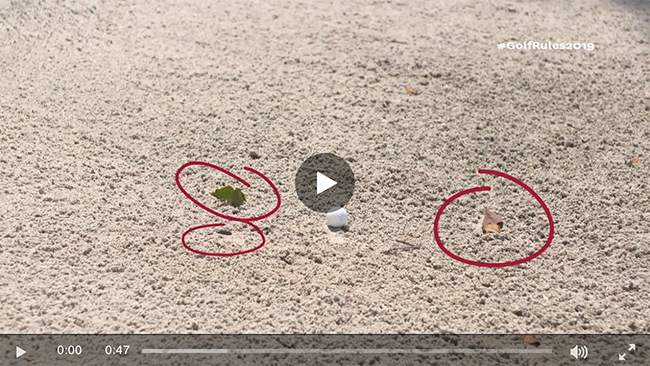
Rule – Unplayable ball in bunker
Relief allowed outside a bunker for an unplayable ball for two penalty strokes.
2019 Rule: The player will have an extra option allowing relief outside the bunker using the back-on-the-line procedure, but for a total of two penalty strokes (Rule 19.3b).
Reasons for Change:
It is not uncommon for a player to need to take unplayable ball relief in a bunker, such as when the ball is very close to the bunker wall or lip.
Playing from a bunker can be very difficult for some players, especially when the bunker has steep walls.
- This can present particular problems in stroke play because the player must finish the hole and so cannot simply pick up and move to the next hole after multiple tries to play the ball from the bunker.
- Giving those players an option for taking relief outside the bunker will allow them to keep playing rather than be disqualified.
This extra option will result in a total of two penalty strokes, to make sure that:
- The penalty is consistent with the significant amount of relief being allowed, and
- This option does not become commonly used by players who are able to play from a bunker.
Check out the VIDEO:
